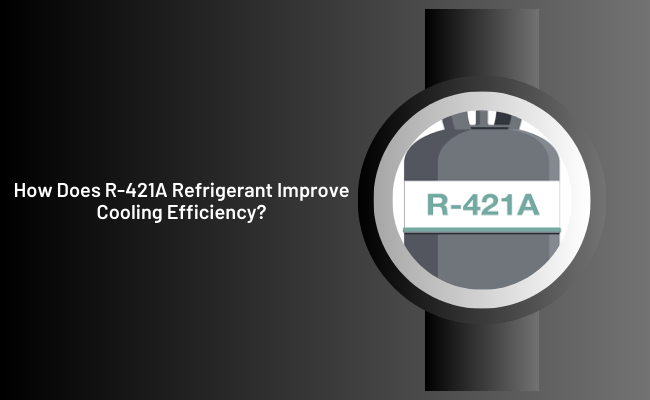Introduction
In recent years, the HVAC (Heating, Ventilation, and Air Conditioning) industry has witnessed remarkable advancements in refrigerant technology to meet the growing demand for energy-efficient and eco-friendly cooling solutions. One such innovation is the R-421A, a high-performance, non-ozone-depleting alternative that has gained popularity as an efficient replacement for traditional refrigerants. In this blog, we will explore the key features and benefits of R-421A Refrigerant and understand how it improves cooling efficiency while contributing to a greener environment.
1. Understanding R-421A Refrigerant
R-421A, commercially known as NU-22B, is a hydrofluorocarbon (HFC) refrigerant blend, specifically designed to replace R-22, a hydrochlorofluorocarbon (HCFC) refrigerant with a significant ozone depletion potential. With growing environmental concerns, R-22 has been phased out due to its detrimental impact on the Earth’s ozone layer. As a result, R-421A has emerged as an eco-friendly alternative, complying with environmental regulations while providing efficient cooling performance.
2. Enhanced Cooling Efficiency
One of the primary reasons R-421A refrigerant has become popular in the HVAC industry is its ability to improve cooling efficiency. This refrigerant blend offers similar cooling capacities as R-22, ensuring that users experience consistent and effective cooling in their air conditioning and refrigeration systems.
The superior cooling efficiency of R-421A can be attributed to its thermodynamic properties. This refrigerant blend has a lower Global Warming Potential (GWP) than R-22, meaning it has a reduced impact on climate change when released into the atmosphere. Additionally, R-421A operates at lower pressures, reducing the strain on the compressor and extending the lifespan of HVAC equipment. As a result, users can enjoy improved cooling performance without compromising on environmental responsibility.
3. Drop-in Replacement for R-22
One of the significant advantages of R-421A is its status as a “drop-in” replacement for R-22. HVAC systems that were originally designed to work with R-22 can seamlessly transition to R-421A without the need for extensive modifications or equipment replacement. This characteristic makes it a cost-effective option for those looking to upgrade their cooling systems without incurring substantial expenses.
However, it is crucial to consult a certified HVAC technician before making the switch. While R-421A is compatible with most R-22 systems, there might be specific cases where minor adjustments or fine-tuning are necessary to optimize its performance. Professional guidance ensures a smooth and successful transition while guaranteeing the highest cooling efficiency with R-421A.
4. Energy Savings and Cost Efficiency
In addition to its enhanced cooling efficiency, R-421A offers energy-saving benefits that translate to reduced utility bills for consumers. By running at lower pressures, HVAC systems utilizing R-421A consume less electricity to maintain the desired cooling levels. Consequently, businesses and homeowners can expect substantial cost savings over the lifetime of their cooling systems.
Moreover, the transition to R-421A can result in financial Incentives for some users. In certain regions, governments and environmental agencies offer rebates and incentives to encourage the adoption of eco-friendly refrigerants. By making the switch to R-421A, users may be eligible for such programs, further offsetting the initial costs of transitioning to this efficient refrigerant.
5. Environmental Benefits
As concerns about climate change and environmental preservation intensify, the HVAC industry is actively seeking greener alternatives to traditional refrigerants. R-421A meets this demand by having a lower GWP and zero ozone depletion potential. By using R-421A, HVAC systems contribute to the reduction of greenhouse gas emissions and help protect the Earth’s ozone layer, making it a responsible choice for a more sustainable future.
6. Improved Heat Transfer Properties
R-421A offers improved heat transfer properties compared to its predecessors. This results in faster and more efficient cooling cycles, ensuring that HVAC systems equipped with R-421A can reach the desired temperature more quickly. Faster heat transfer also leads to reduced wear and tear on the system, extending the equipment’s overall lifespan and reducing maintenance costs.
7. Reduced Risk of Refrigerant Leaks
Refrigerant leaks not only contribute to greenhouse gas emissions but also lead to a decrease in cooling efficiency. R-421A, being a non-ozone-depleting refrigerant, significantly reduces the environmental impact of potential leaks. Additionally, it has a lower leak rate compared to some other refrigerants, which means fewer opportunities for refrigerant loss and subsequent recharging.
8. Wide Range of Applications
R-421A is a versatile refrigerant suitable for various applications, including residential air conditioners, commercial refrigeration units, and industrial cooling systems. Its broad compatibility makes it a viable choice for a wide range of cooling needs, allowing consumers and businesses to enjoy its efficiency and environmental benefits across different sectors.
9. Compliance with Environmental Regulations
Many countries and regions have strict regulations regarding the use of refrigerants with high GWP or ozone depletion potential. R-421A, with its low GWP and zero ozone depletion potential, complies with these regulations, making it a future-proof choice for HVAC systems. Choosing R-421A ensures that users remain in compliance with current and forthcoming environmental standards, avoiding potential penalties or restrictions associated with the use of harmful refrigerants.
10. Safer for Technicians and End-users
Safety is a critical factor in the HVAC industry, both during installation and regular maintenance. R-421A is considered a safe refrigerant to handle, reducing the risks associated with its use for technicians and end-users alike. Its non-toxic properties ensure that accidental exposure to the refrigerant poses minimal health risks, enhancing the overall safety of the cooling systems.
Conclusion
In conclusion, the adoption of R-421A refrigerant represents a significant step forward for the HVAC industry, providing an eco-friendly and energy-efficient solution for cooling needs. Its compatibility as a drop-in replacement for R-22, enhanced cooling efficiency, energy savings, and environmental benefits make it a compelling choice for both commercial and residential applications. As consumers and businesses increasingly prioritize sustainability and cost-effectiveness, R-421A stands out as a viable and responsible refrigerant option for a cooler, greener tomorrow.
Read More: How Safe is R-454B Refrigerant for the Environment?


















Comments